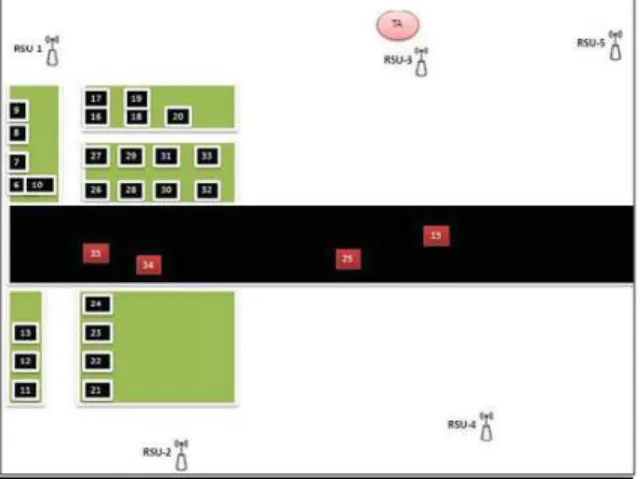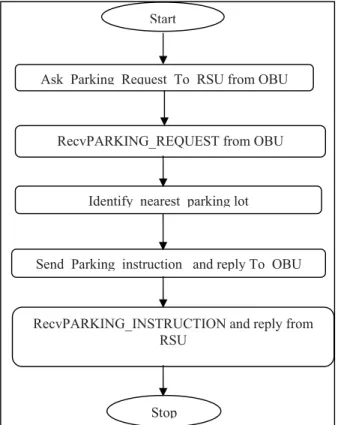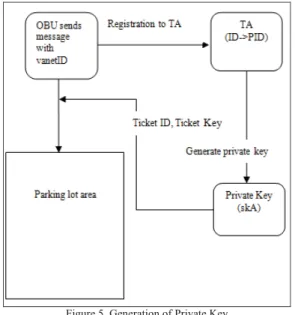PAV: Parking Allotment for Vehicles using
VANET
Dnyaneshwar M. Bavkar Dept. of Computer Engineering Terna Engineering College, Nerul, Navi Mumbai
Vaishali D. Khairnar Dept. of IT
Terna Engineering College, Nerul, Navi Mumbai
Vishwajit B. Gaikwad Dept. of Computer Engineering Terna Engineering College, Nerul, Navi Mumbai
Abstract— Parking is limited in almost every metro city in the world leading to traffic congestion, air pollution, and driver frustration. In large parking lots, a driver may exit the lot without knowing about new spots that have just become vacant. Finding an empty parking spot may also lead to driver frustration if another car takes the spot before the driver can reach it.
With Vehicular ad hoc network intelligent service- oriented parking allotment can improve parking space utilization and drivers frustration. The project inspiration is to fill the near term parking demand using vehicular ad hoc network. The contribution of the project include to provide the real time parking navigation service to the drivers, friendly parking information dissemination service to the drivers means the drivers can easily and quickly get their preferred parking lots close to their destination therefore the parking navigation is convenient and efficient, and increase the space utilization in the parking area. The proposed system will address the performance analysis via simulation demonstration, efficiency and results.
Keywords— Parking system, information Dissemination, On-Board-Unit (OBU), RSU (Road-Side-Unit), TA (Trusted Authority).
I. INTRODUCTION
Finding a vacant parking space in a congested area or a large parking lot, specially, in peak hours, is always time consuming and frustrating to drivers. It is common for drivers to keep circling a parking lot and look for a vacant parking space. To minimize hassle and inconvenience to the drivers, many parking guidance systems have been developed over the past decade, where the system provides accurate, real-time car park space availability to the drivers looking for parking spaces and then guides them to the available spaces by dynamically updated guide signs. The current parking guidance systems obtain the availability of parking spaces using the sensors installed across the whole parking lot. However, deploying sensors in a large parking lot can be very expensive. Furthermore, the sensors can become inaccurate and would stop functioning easily when time passes. Therefore, it is highly desired to have a reliable and cost effective way to track available parking spaces and guide drivers to the available parking spaces. Besides searching for available parking spaces. If the driver have the up-to-date knowledge about the traffic situation like information about the free parking place near the destination area it would be then great benefit.
Vehicle Ad Hoc Networks (VANETs), as shown in Figure 1, have been received particular attention both in industrial and academic levels. With the advance and wide deployment of wireless communication technologies, many major car manufactories and telecommunication industries gear up to equip each car with the On Board Unit (OBU) communication device, which allows different cars to communicate with each other as well as roadside infrastructure, i.e., Roadside Units (RSUs), in order to improve not only road safety but also better driving experience. Therefore, it becomes possible to track the parking space occupancy, guide drivers to the empty parking spaces in large parking lots through vehicular communications.
II. RELATED WORK
Now a day’s many vehicle manufacturing companies provide the On Board Unit (OBU) communication devices. The current parking systems obtain the parking space availability using sensors installed in the parking zone. The deployment of the sensors in the parking zone is very expensive; it can be inaccurate and would stop the functioning when time passes. Therefore it is desirable to have a reliable and cost effective way to track the available parking space and guide the drivers [2].
In Wireless ad hoc Discovery of Parking Meters they have proposed a scenario of wireless ad hoc networks for finding free parking places. They use multi-hop dissemination of information only among interlinked parking meters, and not among vehicles. Requests from vehicles for parking places are received and handled by such a parking meter via single-hop communication [5].
In SVATS: A sensor-network-based Vehicle Anti-Theft System they presented a sensor-network-based vehicle anti-theft system. In the system, the sensors in the vehicles that are parked at the same parking lot first form a sensor network and then monitor and identify possible vehicle thefts by detecting unauthorized vehicle movements [7].
In Smart Parking: an Application of optical Wireless Sensor Network , the authors present a smart parking management system based on wireless sensor network technology, which provides remote parking monitoring, automated guidance and parking reservation service. They demonstrate this system architecture can help commuters to find vacant parking spaces [8].
In Towards an Intelligent GPS-based Vehicle navigation system for finding street parking lots has described algorithm to find the most likely available parking lots within a specified distance from the destination. The proposed algorithm utilizes the occupancy history and the present status of a parking lot in order to determine its availability at the time when the vehicle would likely reach the destination [10].
III. DESIGN GOAL
To provide the convenient parking services to the driver in the parking lots, we assumed the TA (Trusted Authority) which will be the registration in-charge of both RSU and OBU to keep the secret of RSU and OBU if any exceptional event occurs. Vehicles are equipped with the sensing computing and wireless devices. The RSUs are installed in the parking lot to get the request message from OBU and to provide the correct information about the vacant parking space back to the OBU. Specifically, the Parking system makes the following contributions.
x The system can provide real-time parking navigation service to drivers in large parking lots. With the real-time parking navigation, the drivers can get the vacant parking space quickly. Therefore, the gasoline and time wasted in search of vacant parking space can be reduced. To the best of our knowledge, this is the first such effort in the context of VANET-based real-time parking navigation.
x The system can provide friendly parking information dissemination service to the moving vehicles. With this friendly parking information, the drivers can conveniently and quickly choose their preferred parking lots close to their destinations.
IV.SYSTEMSSETUP
Considered system model consist of the TA (Trusted Authority), OBU (On Board Unit) which is equipped in the Vehicles, stationary RSU (Road Side Unit) which is deployed in the Parking area.
x Once the vehicles enters into the parking
into PIDv and generates the private key Sk. When OBU enters into the parking lot it will receive the ticket ID and the ticket key which is known to driver only.
x Here we deployed the 5 RSUs in the parking lot,
These all RSUs cover all the parking lot with road side. All these parking lot are inspected by the TA, TA will generate the corresponding private key for the identifiers and distribute the private key to these parking lot RSUs. The RSUs transmission range used here is recommended by the IEEE 802.11p Wireless Access in Vehicular Environments (WAVE) standard.
Following figure.2 shows the model we considered for the parking system.
Following steps shows the communication between the OBU to OBU, and OBU to RSU and vice versa. 4.1 Ask Parking Request To RSU from OBU:
The driver, who wants to park his vehicle, will send the parking request to RSU, with vanetID_, current timestamp, and current position (rbc_posx, rbc_posy) from where the request is sent by the OBU, and then the packet will be scheduled for broadcasting through the downtarget of LL(linked layer) and querying the mapping of the given destination address.
Figure 2. A typical parking lot model under consideration
4.2 Receiving the parking request from OBU:
Figure 3. OBU/RSU Communication
4.3 Receiving the parking request from OBU:
Here, RSU will receive the parking request message from OBU with the header information rbc_senderID, and then RSU will reply back to the OBU by calling the Send_Parking_Instruction_To_OBU(rbc_senderID), by searching the available parking point from the respective parking lot and update the routing information of the parking lot with the current time-stamp.
4.4 Identify nearest parking lot:
When the OBU enters into parking lot the RSU choose the proper vacant parking points (lot_x, lot_y), the five RSUs synchronically measures the distance from the vehicle to themselves. With the vacant parking points (lot_x, lot_y) and the position of the vehicle (X, Y), the RSU choose the shortest path for the vehicle and navigate the vehicle to the vacant parking space. To calculate the nearest parking points for the requested OBU following formula is used:
Nearest distance=(x-x1)2+(y-y1)2 (1)
4.5 Send Parking Instruction To OBU(nsaddr_t nid):
After finding the vacant parking position points at the parking lot with nearest parking points, the parking point information is sent to the respective OBU from where the parking request is received; with the Parking_lot_ID and parking points(x, y).
4.6 Receive the Parking instructions from RSU
Requested OBU receives the parking information from the RSU about the free parking points(x, y) and Parking_lot_ID _id.
4.7 Send the parking reply to OBU:
With the parking instruction the RSU will send the parking reply to the OBU with the RSU_ID and the parking points (x, y)
Start
Ask Parking Request To RSU from OBU
RecvPARKING_REQUEST from OBU
Identify nearest parking lot
Send Parking instruction and reply To OBU
RecvPARKING_INSTRUCTION and reply from RSU
4.9 OBU registration at TA(Trusted Authority)
In our considered scenario first every OBU will do the registration of himself at TA by sending the registration message to TA with his vanetID, and current time-stamp
4.10 Receive registration message by TA:
After receiving the registration message from OBU, TA will do the registration of the OBU and generate the private key (skA) for the OBU. Once the vehicles enters into the parking area the identification should be kept secret for an exceptional event occurs, so the RSU can get the information about the registered vehicle from the TA
Secure Hash Algorithm (SHA-1)
Here we used SHA-1 algorithm to generate the Private Key for every vehicles those have registered with TA (Trusted Authority). Following figure.3 shows the working of SHA-1 to generate the secure private key for the OBUs those are registered with the TA.
SHA works with any input message that is less than 264 bit length. The output of SHA is a message digest, which is 160 bits in length. This SHA-1 requires 2160 operations to break in, if any attacker try to find out the original message (here vanetID_) therefore it is more secure
Figure. 4 Single SHA-1 iteration [11]
OBUs are installed in the vehicles; they can communicate with each other and RSUs to get the parking lot information. Every OBU will have the unique identifier (vanetID_) to protect the privacy of the OBUs. When OBU with vanetID_ registers itself to Trusted Authority (TA), TA converts the vanetID_ into pseudo-id, and generates the private key skA corresponding to the pseudo-id of the OBU. When an OBU enters into the parking lot, it will receive the pair of ticket ID and respective ticket key, which is only known to the driver. Following figure.4 shows the generation of private key (skA) Ticket ID, Ticket key sends to the OBU in the parking lot area. Following lines shows the generated keys by the TA for vanetID_ 45.
Example 1.
Receive Registration Message by 0 Send Generated Key to 45
Figure 5. Generation of Private Key
IV.RESULT
Figure 5. Shows the scenario generated for the parking system using Ns2. For the parking system we set 5 RSU, 1 TA, and the vehicles moving on road. Once the vehicles enters into the parking area the identification should be kept secret for an exceptional event occurs, so the RSU can get the information about the registered vehicle from the TA. TA is the registration in charge of the both RSU and OBU. TA first initializes the required parameters. TA inspects the parking lot and generates the private key (skA) and stores the same private keys into the five RSUs.
Figure 6. Parking system Scenario in ns2
Performance Metrics to evaluate simulation:
Packet delivery ratio (PDR):
Packet delivery ratio is the ratio to evaluate the performance of the simulation. The ratio of the packets that successfully reach destination.
This metric gives the overall delay, from packet transmission by the application agent at the source node till packet reception by the application agent at the destination node. The following equation is used to calculate the average end-to-end delay,
End-to-End Delay = (T_DataR – T_DataR) Received packets
Where T_DataR = Time data packets received at destination node, T_DataR = Time data packets sent from source node. Further End to end delay is defined as the average delay experienced by all connections throughout the simulation experiment. Each data transmission between a source and a destination will experience a network delay in the network. The delay is defined as the difference in time the moment all transmission of packets are delivered and the time these packets are all actually received. The aggregate of all such connections delays is found and averaged over the total number of transmission connections pairs. Delay is a significant factor due to the necessity to provide low latency applications such as video on- demand and other time-sensitive applications, e.g., IP telephony. It typifies the suitability of using certain routing protocols to support these applications. The following table shows the values we got after execution of the scenario for No. Of packet
Sent/Receive/Drop, Packet Delivery Ratio, Throughput, end to end delay, packet drop ratio shows for the different packet interval time for 35 nodes
Pkt. Inte rval time
No. Of Pkt Sent
No. Of Pkt Recv
PDR Throughp ut
End to end
delay Pkt. Drop Ratio
0.1 3770 3163 83.8% 142881 1.63 16.10%
0.2 1890 1538 81.3% 68793 0.65 18.62%
0.3 1260 1025 81.3% 47081 3.10 18.65%
0.4 950 694 73.0% 31051 0.79 26.94% 0.5 760 577 75.9% 25887 0.37 24.07%
Number of Packet Sent/Receive/Drop:
Following Figure shows the Number of Packet Sent/Receive/Drop in the network.
Packet Delivery Ratio:
Throughput:
Following result shows the total number of packets handled by the scenario at the different packet interval time.
End-to-End Delay:
Following result shows the overall delay, from packet transmission by the application agent at the source node till packet reception by the application agent at the destination node.
Packet Drop Ratio:
V. CONCLUSIONS
In this paper, we have proposed a new VANET-based parking system. RSUs installed across a parking lot can surveil the whole parking lot, and provide convenient services for drivers to reduce the searching time delay for an available parking space, and to save the fuels and drivers parking time: 1) real-time parking navigation; 2) friendly parking information dissemination. Later we did a survey on many papers and generated an idea that will be helpful to finding the parking place in parking lot using VANET.
In This project we proposed a intelligent parking system by using the vehicular ad-hoc network. It will be an intelligent parking service application
First, vehicles on the road can view and reserve a parking spot. The parking process can be an efficient and non-stop service. On the other hand, parking service is an intelligent service. New vacant parking spot can be distributed to the cars passing by.
Second, the parking process has been modeled as a stochastic process. Not only maintenance work can be scheduled but also the revenue of the parking site can be predict. New business promotions can be broadcasted to all vehicles passing by the parking site through wireless networks.
Finally, privacy of the drivers and security of the information are protected by using the sensor infrastructure and encryption/decryption approach. Simulation results prove the proposed system results in high parking space utilization and fast parking spot finding time. The future work includes more extensive simulations on the proposal. The analysis of efficiency needs to be studied as well.
REFERENCES
[1] Rongxing Lu, Xiaodong Lin, Haojin Zhu, and Xuemin (Sherman) Shen, “SPARK: A New VANET-based Smart Parking Scheme for Large Parking Lots”, IEEE Communications Society subject matter experts for publication in the IEEE INFOCOM 2009 proceedings, 978-1-4244-3513-5/09, 009.
[2] V. Tang, Y. Zheng, and J. Cao, “An intelligent car park management system based on wireless sensor networks,” in Proc. of the First International Symposium on Pervasive Computing and Applications, Urumchi, Xinjiang, P.R. China, pp. 65-70, August 2006. [3] Murat Caliskan, Andreas Barthels, Björn Scheuermann, and Martin Mauve, “Predicting Parking Lot Occupancy in Vehicular Ad Hoc
Networks”, Volkswagen AG, Wolfsburg, Germany, 1550-2252, 2007.
[4] R. Panayappan, J. Trivedi, A. Studer, and A. Perrig, “VANET-based approach for parking space availability,” in Proc. of the Fourth ACM International Workshop on Vehicular Ad Hoc Networks (VANET 2007), Montr´eal, Qu´ebec, Canada, pp. 75-76, Sept. 2007.
[5] P. Basu and T. D. Little, “Wireless ad hoc Discovery of Parking Meters,” in WAMES ’04: Proceedings of the MobiSys 2004 Workshop on Applications of Mobile Embedded Systems, Boston MA, USA, June 2004, pp. 8–11.
[6] “ParkSens,” http://www.parksens.com/.
[7] H. Song, S. Zhu, and G. Cao, “SVATS: A sensor-network-based Vehicle Anti-Theft System,” in Proc. IEEE INFOCOM’08, Phoenix, AZ, USA, April 14-18, 2008.
[8] J. Chinrungrueng, U. Sunantachaikul and S. Triamlumlerd, “Smart Parking: an Application of optical Wireless Sensor Network,” in Proceedings of Application and the Internet Workshops, 2007.
[9] Fan Li and Yu Wang; “Routing in Vehicular Ad Hoc Networks: A Survey”, IEEE Vehicular Technology Magazine, Volume 2, Issue 2, June 2007
[10] Sherisha Pullola, Pradeep K. Atrey and Abdulmotaleb El Saddik,” TOWARDS AN INTELLIGENT GPS- BASED VEHICLE NAVIGATION SYSTEM FOR FINDING STREET PARKING LOTS”, 2007 IEEE International Conference on Signal Processing and Communications (ICSPC 2007), 24-27 November 2007, Dubai, United Arab Emirates.
![Figure 1. Vehicular Ad-hoc Network [6]](https://thumb-eu.123doks.com/thumbv2/123dok_br/17116530.238229/1.918.284.638.904.1066/figure-vehicular-ad-hoc-network.webp)


